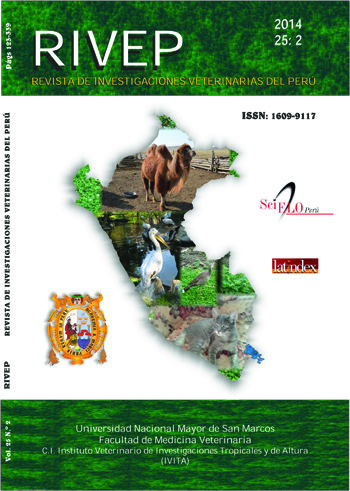GASTROINTESTINAL PARASITISM IN TWO SEASONS IN GUINEA PIGS (Cavia porcellus) OF OXAPAMPA, PASCO
DOI:
https://doi.org/10.15381/rivep.v25i2.8500Keywords:
Cavia porcellus, endoparasitism, prevalence, production phase, risk fac-tor, OxapampaAbstract
The objective of the study was to determine the prevalence of gastrointestinalparasites in the rainy and dry season in guinea pigs (Cavia porcellus) in semi-commercialfarms in Oxapampa, Paso, Peru, as well as to identify the parasite species and to assessthe season and productive phase as risk factors. Two hundred faecal samples per season were collected where the experimental unit was the cage. The samples were processed bythe flotation, sedimentation and modified McMaster methods. The prevalence was 90.0± 4.1 and 63.5 ± 6.7% in the rainy and dry season respectively, and the identified specieswere Paraspidodera uncinata, Trichuris spp, Capillaria spp, and Eimeriacaviae. Onthis, E. caviae and P. uncinata showed the higher frequencies in both seasons. The rainyseason represented a risk of 5.7-fold relative to the dry season, especially for E. caviae(8.2), while the rearing phase represented a risk of 2.2-fold relative to breeding animals,especially for P. uncinata (2.6) and E. caviae (2.5), while breeding animals showed ahigher risk of infection for Capillaria spp (6.2) in relation to the growing animals.Downloads
Downloads
Published
Issue
Section
License
Copyright (c) 2014 Merly Vargas R., Amanda Chávez V., Amanda Chávez V., Rosa Pinedo V., Siever Morales C., Rosa Pinedo V., Francisco Suárez A., Siever Morales C., Francisco Suárez A.

This work is licensed under a Creative Commons Attribution-NonCommercial-ShareAlike 4.0 International License.
AUTHORS RETAIN THEIR RIGHTS:
a. Authors retain their trade mark rights and patent, and also on any process or procedure described in the article.
b. Authors retain their right to share, copy, distribute, perform and publicly communicate their article (eg, to place their article in an institutional repository or publish it in a book), with an acknowledgment of its initial publication in the Revista de Investigaciones Veterinarias del Perú (RIVEP).
c. Authors retain theirs right to make a subsequent publication of their work, to use the article or any part thereof (eg a compilation of his papers, lecture notes, thesis, or a book), always indicating the source of publication (the originator of the work, journal, volume, number and date).










